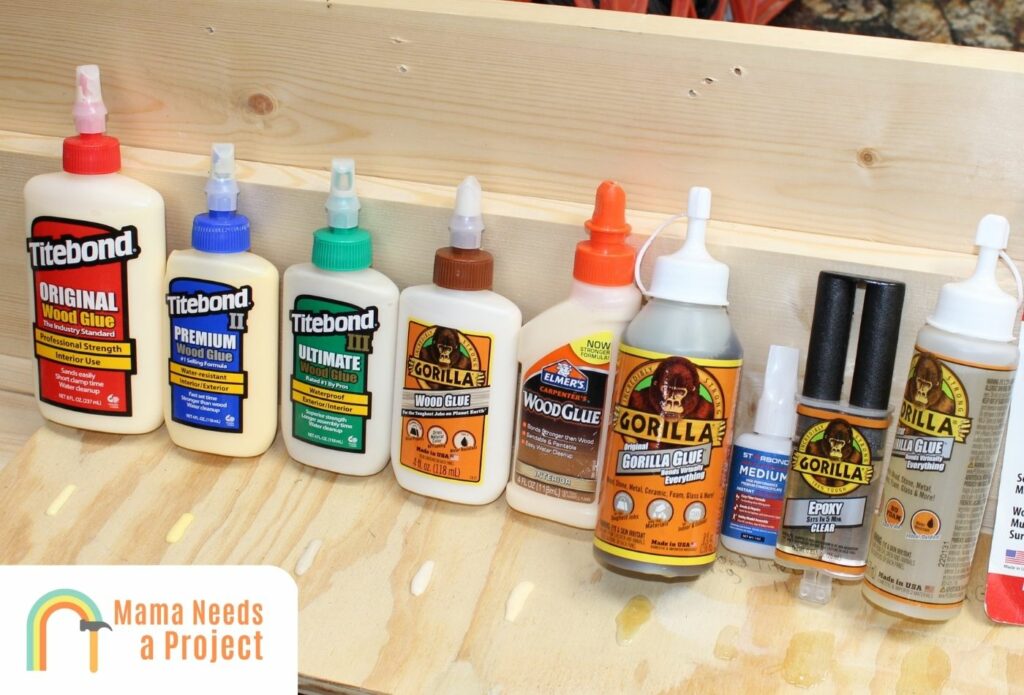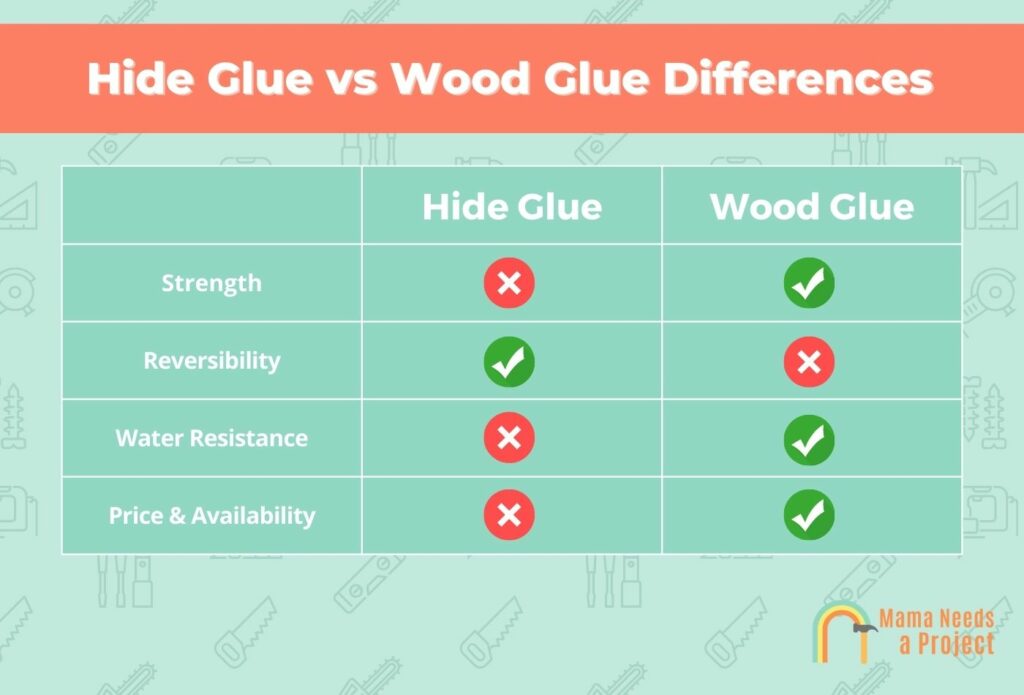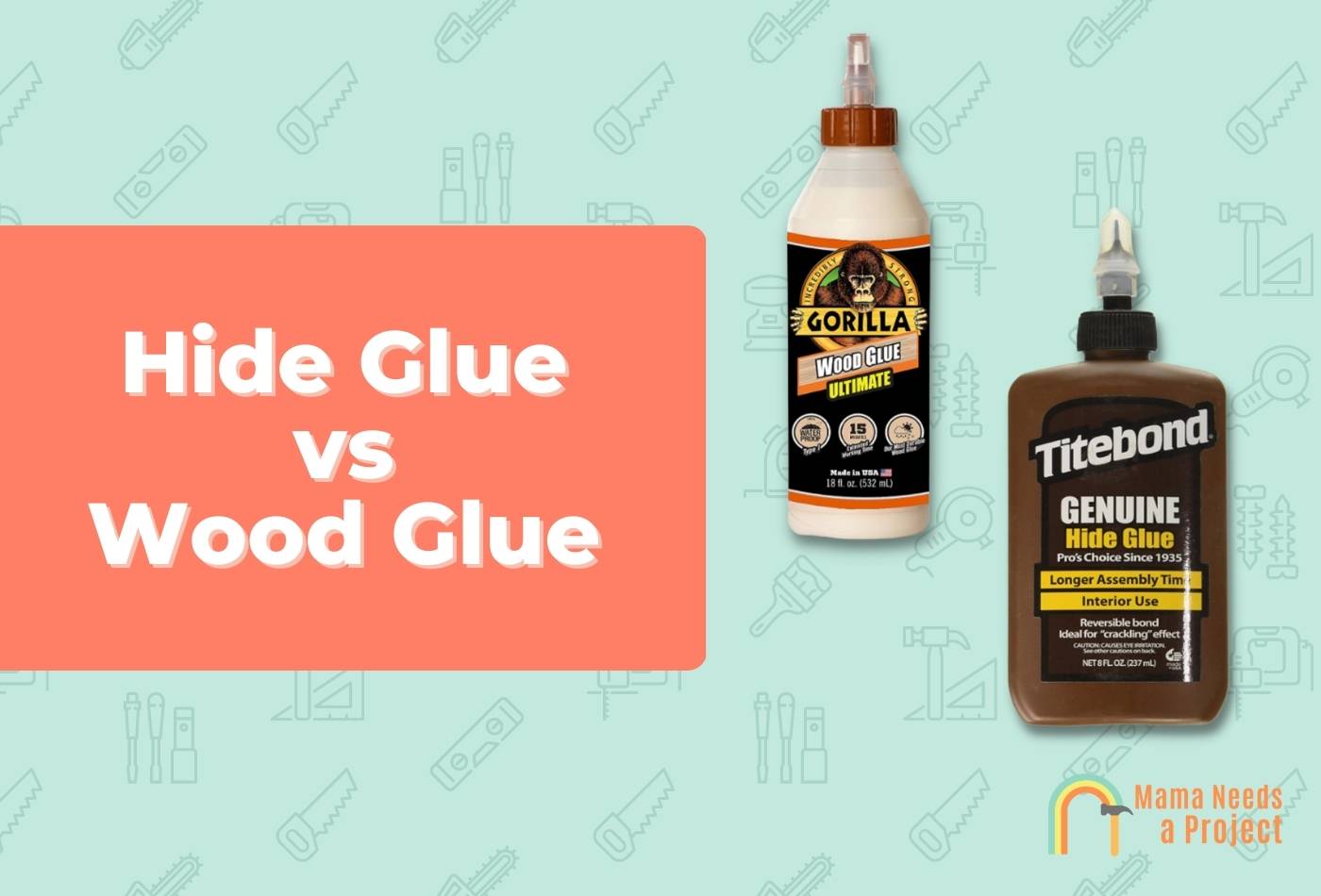Hide Glue vs Wood Glue (Which is Better for Woodworking?)
Hide glue and wood glue are two common adhesives you’ll run across on your next woodworking project.
These binders are pretty similar, but there are some differences you’ll want to keep in mind.
In this post, I’ll explore hide glue vs wood glue, which glue is a better choice for your project, and much more. Let’s dig in.
What is Hide Glue
Hide glue is a more natural adhesive used by many woodworkers to bond wooden components together.
Hide glues are constructed with natural animal hides that are melted down and dry hard when cooled.
Hide glue shrinks slightly when it dries, so be sure to use the right amount for your project to get a proper seal.
Traditionally, hide glues were sold to be heated and mixed with hot water before they could be applied. Now, you can purchase bottled hide glue that doesn’t require heat when applying to glue joints.
Advantages of Using Liquid Hide Glues
- Can be removed
- Gives a more natural look
- No VOCs or harmful chemicals
- Bonds with existing hide glue
Disadvantages of Hide Glues
- Not as strong as wood glue
- More expensive
- Not as water resistant
- Short assembly time
How to Use Hide Glue
To use liquid hide glue, simply open your bottle, apply the hide glue to the desired area, clamp the wood, and allow it to dry completely. You can also check out the video below!
What is Wood Glue
Wood glue is the classic adhesive that’s considered an essential for any woodworker. You can use it to connect wood surfaces and joints together with a long lasting bond.
Wood glue is perfect for just about all woodworking projects because it’s extremely versatile.
There are tons of wood glues on the market from reputable brands like Titebond, Elmers, and Gorilla Glue that are all great options.
Wood glues come in a variety of options depending on your needs and believe it or not, wood glue is stronger than the wood it’s connecting.

Types of Wood Glues
- PVA glue
- Polyurethane wood glue
- Cyanoacrylate wood glue (also known as super glue)
- Epoxy wood glue
Advantages of Using Wood Glues
- Superior bond strength
- More water resistant
- Less expensive
- Fast drying options
Disadvantages of Wood Glues
- Cannot be removed once dry
- Not a natural adhesive
- Some types of wood glue can be slow drying
How to Use Wood Glue
To use wood glue, simply open your bottle, apply the wood glue to the desired area, clamp your wood together, and let it dry.
It’s important to note that there’s a difference between wood glue drying times and curing times.
Just because the wood glue is dry to the touch, doesn’t mean it’s completely cured and good to use quite yet. You should always allows you projects to fully cure before doing anything with it.
Differences Between Hide Glue vs Wood Glue

1. Strength
When it comes to strength and durability, wood glue is the superior choice. At the end of the day, if you need to bond two pieces of wood and you won’t have to adjust it ever again, use wood glue.
Because of its chemical composition, wood glue will give you a longer lasting, more durable, and stronger bond than hide glue.
The strongest wood glues are polyurethane and epoxy.
Polyurethane wood glues are waterproof and can withstand large temperature changes, which makes it great for exterior projects.
Some epoxy wood glues require you to mix the substances together while others come with an applicator that mixes it when applied.
That said, hide glue is still relatively strong and can be used on some wood projects like furniture.
2. Color
Wood glue and hide glue can give off a different appearance once dried.
Hide glues dry with a clear, transparent finish that don’t leave stains.
Most wood glues can dry with a yellowed or off-white finish that leaves stains on your project.

While there are some wood glues that promote a clear finish, it’s still not as transparent as most hide glues.
Wood glues can be sanded and stained to get a more accurate color, but this requires more work on your part.
This means if you’re working on furniture or another piece of home decor where you want the glue to be undetectable – go with hide glue.
3. Reversibility
Another key difference between wood glues and hide glues is reversibility. In other words, the ability to remove the glue at a later time to make adjustments or tweaks to your project.
You can remove hide glue by applying some heat and humidity to the area so you can make adjustments as needed.
Wood glue is not nearly as reversible. I wouldn’t say it’s impossible to remove wood glue, but it’s much more difficult.
4. Working Time or Assembly Time
There’s also a difference in the assembly time between both glues.
Wood glues tend to have a longer working time than most hide glues.
It’s worth noting that you can find fast drying wood glues, which will decrease the assembly time you have.
5. Water Resistance
Hide glues are notoriously less waterproof than wood glues.
Because of hide glues reversibility with heat and humidity, this also means it won’t be nearly as waterproof as a typical wood glue.
So if you’re working outdoors, I wouldn’t recommend using hide glue.
6. Chemical Makeup
One obvious difference between hide glues and wood glues is what they’re made of.
As the name suggests, hide glues are comprised of collagen found in animal hides.
Wood glues are made from a variety of chemicals and synthetic ingredients mixed together in liquid form that creates a strong bond when dry.
Some wood glues are make of wood fibers in addition to the other ingredients that give it a more natural composition and additional strength.
7. Price
Hide glues are often more expensive than most wood glues. Because of the natural composition of hide glue, you can expect it to cost more to manufacture, and cost to consumers.
Depending on the type of wood glue you’re comparing it to, hide glues can cost around twice as much as a standard wood glue.
8. Availability
In addition to the price difference, wood glues are much easier to find than hide glues.
While you can purchase both varieties online, it’s going to be more difficult to find hide glues at your local hardware store.
If you specifically want hot hide glues, it’ll be even more of a challenge to find at a local store.
When Should You Use Hide Glue?
Hide glue is best used for restoring old furniture, musical instruments, antiques, or decor where you need to make adjustments later on. Because of hide glues reversibility, this makes it the best glue for the job.
Additionally, if you need a clean finish that doesn’t leave stains behind, using hide glue makes sense.
When Should You Use Wood Glue?
Wood glue is best for woodworking projects that require more strength and durability.
If you need to bond joints and wood pieces that don’t require reversibility, wood glues are a better option.
Additionally, if you’re working on an exterior project that is exposed to the elements, using a water resistant wood glue is ideal. For example, outdoor furniture should always use wood glue because hide glue will deteriorate with the humidity.
What is the Best Wood Glue?
If you’re ready to purchase some wood glue, my favorite is the Gorilla Wood Glue. This PVA wood glue has everything you’re looking for including water resistance, a strong bond, the price tag to make it a no brainer. It dries with a slightly yellow appearance to match the color of some woods.
- Incredibly strong wood glue: Gorilla Wood Glue Ultimate formula is 100% waterproof and incredibly strong, but...
- Indoor and outdoor use: Great for outdoor applications where temperatures or moisture might be a concern, as...
- Waterproof and durable: Our versatile and waterproof wood sealer, passes the ANSI/HPVA Type 1...
If you don’t like the Gorilla Glue brand, I would recommend the Titebond Wood Glue as your next best choice but either way, it’s hard to go wrong with these wood glues on your woodworking projects.
What are the Best Hide Glues?
If you’re working on furniture or other more delicate wood projects, purchasing hide glue is an obvious choice. My favorite hide glue is the Titebond liquid hide glue. It has the reversible bond that you’re looking for and have a longer assembly time to give you more freedom and flexibility.
- This item is Franklin International 5013 Titebond Liquid Hide Glue, 8-Ounce
- Used for Hardware Glue
- This product is Manufactured in United States
FAQs
Is hide glue as strong as wood glue?
No, hide glue is not as strong as most wood glues. If you need strong bond strength, go with a wood glue. While hide glue is still relatively strong, it’s not as strong as wood glue.
Can you use hide glue on wood?
Yes, hide glue can be used on wood of all types and woodworking projects. Just be sure to keep your wood away from moisture and high heat as this can cause hide glue to break down.
Does hide glue need to be clamped?
While it’s not required, clamping hide glue will yield a stronger bond. The clamping time will depend on the project but in most cases 20 to 30 minutes will do the trick.
What is hot hide glue?
Hot hide glue is a traditional hide glue that requires heat and water to melt into an applicable adhesive. Newer hide glues do not require you to heat them to get the same affect.
Is hide glue permanent?
No, hide glue is not permanent and can be removed with a warm, wet rag. Wood glue is more permanent and much more difficult to remove.
How to remove hide glue?
To remove hide glue from wood, just rub the area with a warm, damp rag until the glue has dissolved from the surface. You can also spray a small amount of hot water on the area and wipe it with a clean cloth.
Final Thoughts on Hide Glue vs Wood Glue for Woodworking
At the end of the day, both adhesives can be used to bond wood together, however, which one you should use depends on the project.
If you need a strong bond that will last, go with wood glue.
If you need an adhesive that drys clear and can be reversed – go with a hide glue.
The best wood glues for your project will ultimately depend!



